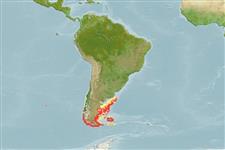Common names from other countries
Classification / Names / Names
Namen | Synonyme | Catalog of Fishes (gen., sp.) | ITIS | CoL | WoRMS
Environment: milieu / climate zone / depth range / distribution range
Ökologie
; tiefenbereich 0 - 90 m (Ref. 83435). Temperate; 38°S - 56°S, 74°E - 57°E (Ref. 83435)
Southeast Pacific and Southwest Atlantic: Chile, Falkland and Argentina.
Length at first maturity / Size / Gewicht / Alter
Maturity: Lm ? range ? - ? cm Max length : 2.4 cm DL Männchen/unbestimmt; (Ref. 83435)
It is found on rocky substrates, on or beneath rocks, in rock crevices, rocky walls and tide pools, and on brown algae (Ref. 87801), like forests of Macrocystis pyrifera (Ref. 92889).
Life cycle and mating behavior
Geschlechtsreife | Fortpflanzung | Ablaichen | Eier | Fecundity | Larven
Egg masses are composed of 4 to 19 egg capsules, containing 1 to 5 embryos developing within each capsule and emerges as crawling juveniles. Egg capsules are attached to a substrate.
Rosenberg, G. 2009. (Ref. 83435)
IUCN Rote Liste Status (Ref. 130435)
CITES Status (Ref. 108899)
Not Evaluated
Not Evaluated
Nutzung durch Menschen
| FishSource |
Tools
Mehr Information
Alter/Größe
Wachstum
Länge-Gewicht
Länge-Länge
Morphologie
Larven
Dichte
Internet Quellen
Estimates based on models
Preferred temperature
(Ref.
115969): 6.3 - 13.1, mean 8.6 (based on 194 cells).
Preiskategorie
Unknown.
